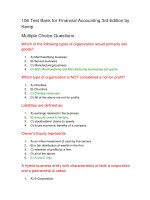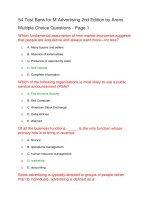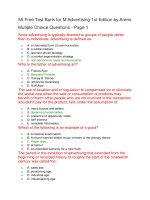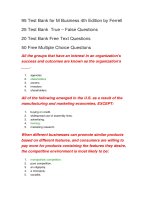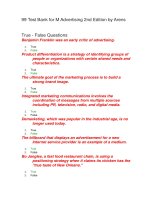135 test bank for m marketing 4th edition by grewal đề trắc nghiệm marketing
Bạn đang xem bản rút gọn của tài liệu. Xem và tải ngay bản đầy đủ của tài liệu tại đây (203.61 KB, 40 trang )
135 Test Bank for M Marketing 4th Edition by Grewal
True - False Questions
Over the past decade or so, marketers have begun to realize that it is best
to structure a firm's customer orientation in terms of transactions rather
than relationships.
1.
True
2.
False
Value is what you get for what you give.
1.
True
2.
False
Firms have come to realize that good corporate citizenship through
socially responsible actions should be a priority because it will help their
bottom line in the long run.
1.
True
2.
False
The power adapters Dell sells with its computers are built by small
companies that specialize in power-related accessories. Dell and the
power adapter manufacturers are engaging in B2B marketing.
1.
True
2.
False
Effectively managing supply chains has a minimal effect on profitability.
1.
True
2.
False
The four Ps include product, promotion, planning, and place.
1.
True
2.
False
A group of firms that makes and delivers a given set of goods and
services is known as a distribution channel.
1.
True
2.
False
Buffalo Wild Wings suggests that its diners check in to its locations using
their phones. This demonstrates the use of social media to market a
product.
1.
True
2.
False
Good marketing is not a random activity.
1.
True
2.
False
Marketing's fundamental purpose is to create value by developing a
variety of offerings that will earn income for the company.
1.
True
2.
False
The trade of things of value between the buyer and the seller so that each
is better off as a result is known as an exchange.
1.
True
2.
False
The text highlights one entrepreneur who was a billionaire by the age of
50. This person is Warren Buffet.
1.
True
2.
False
When a good or service is promoted, the purpose of the promotion is to
inform, persuade, or remind customers.
1.
True
2.
False
Marketing is an activity that only large firms with specialized departments
can execute.
1.
True
2.
False
Garage sales and online classified ads are examples of C2C marketing.
1.
True
2.
False
Firms become value-driven, in part by focusing on the competition.
1.
True
2.
False
Margo likes her morning coffee, and she always stops at Starbucks
because it is on her way to work. Margo is being influenced by the place
element of the marketing mix.
1.
True
2.
False
The group of firms that makes and delivers a given set of goods and/or
services is called a supply chain.
1.
True
2.
False
Entrepreneurial companies are unable to control their marketing mixes.
1.
True
2.
False
Approximately half of U.S. companies now use social media tools for
marketing purposes.
1.
True
2.
False
In value co-creation, the customer participates in the creation of a good or
service, which provides additional value to the customer.
1.
True
2.
False
Marketers might wish to sell their products to everyone, but it is not
practical to do so.
1.
True
2.
False
Foursquare is an example of a location-based social media application.
1.
True
2.
False
When a manufacturer sells truck and car parts to Toyota, this is an
example of B2C marketing.
1.
True
2.
False
Understanding a customer's needs and wants is fundamental to marketing
success.
1.
True
2.
False
Multiple Choice Questions - Page 1
Many U.S. companies first discovered marketing during the __________
era.
1.
production-oriented
2.
sales-oriented
3.
market-oriented
4.
value-based marketing
5.
retailing-oriented
Marketing channel management is also known as
1.
endless chain marketing.
2.
a transactional orientation.
3.
wholesaling.
4.
product design.
5.
supply chain management.
The importance of supply chain management is often overlooked in the
study of marketing because
1.
marketing has no responsibility for supply chain management.
2.
supply chain management doesn't add much value for customers.
3.
companies do not want customers to know anything about the supply chain.
4.
many of the activities take place behind the scenes.
5.
supply chain management is already transparent.
__________ is communication by a marketer that informs, persuades, or
reminds potential customers about a product.
1.
Pricing
2.
Promotion
3.
Placement
4.
A relational orientation
5.
Value co-creation
Henriette offers financial counseling and management on a fee-only basis.
She has found that different customers are willing to pay different rates
for her services. This shows that her pricing decisions should depend
primarily on
1.
choosing an average price that she will charge all her clients.
2.
changes in technology allowing consumers to manage their own affairs.
3.
how different customers perceive the value of her services.
4.
changes in the economy.
5.
how much her competitors charge for similar services.
The marketing goal of getting the right quantities to the right locations at
the right time relates to
1.
communicating the value proposition.
2.
supply chain management.
3.
service marketing.
4.
capturing value.
5.
price and performance management.
UPS, FedEx, DHL, and other shipping companies support other firms'
__________ marketing goals.
1.
supply chain management
2.
value communication
3.
value capture
4.
retail management
5.
promotion
Whenever Valerie has a new massage therapy customer, she invites the
person to be on her e-mail distribution list. In the process, in addition to
exchanging her massage therapy service for payment, Valerie is gathering
1.
information.
2.
promotional capital.
3.
pricing data.
4.
value cocreation.
5.
feedback.
When considering career choices in marketing, many students overlook
supply chain management because
1.
it is considered too quantitative.
2.
marketing has no responsibility for supply chain management.
3.
companies generally outsource these activities, so there are rarely supply chain
jobs available.
4.
it only takes place in large, urban areas.
5.
many of the activities take place behind the scenes.
Julia is considering a career in marketing. She is concerned about the
image of marketers as fast-talking, high-pressure people who only care
about making a sale. When reading about the core aspects of marketing,
Julia is relieved to see that in marketing
1.
all parties to an exchange should be satisfied.
2.
promotion is the most important consideration, followed by pricing decisions.
3.
decisions are made regarding how a product is designed.
4.
customers are not considered until the product is ready for sale.
5.
distribution is controlled by customers.
Four Winds Art Gallery recently began offering appraisals of customers'
art collections, in addition to continuing to sell paintings. Four Winds is
1.
expanding from offering just services to also offering goods.
2.
implementing a market segmentation strategy.
3.
capturing value through multiple pricing strategies.
4.
expanding from offering just goods to also offering services.
5.
increasing customer value through inflated appraisal evaluations.
Henry Ford's statement, "Customers can have any color they want so long
as it's black," typified the __________ era of marketing.
1.
production-oriented
2.
sales-oriented
3.
market-oriented
4.
value-based marketing
5.
retailing-oriented
When a T-shirt manufacturer states, "We only sell it in black because that
way we can buy plenty of black fabric and run our plant efficiently," its
statement reflects the views that were popular in which era of the
evolution of marketing?
1.
production-oriented
2.
sales-oriented
3.
market-oriented
4.
value-based marketing
5.
economics-oriented
Yesenia, the new university course scheduling manager, is struggling with
adjustments to the fall schedule. She is trying to determine how to offer
the classes students need at the times when students need them. Yesenia
is struggling with the marketing function of
1.
communicating the value proposition.
2.
supply chain management.
3.
creating value.
4.
capturing value.
5.
value co-creation.
The idea that a good product will sell itself is associated with the
__________ era of marketing.
1.
production-oriented
2.
sales-oriented
3.
market-oriented
4.
value-based marketing
5.
retailing-oriented
During the __________ era, firms had excess capacity and used personal
selling and advertising to generate customers.
1.
production-oriented
2.
sales-oriented
3.
market-oriented
4.
value-based marketing
5.
retailing-oriented
Near the end of the model year, Move-Them-Out automobile dealership
had an unusually high inventory level. The manager increased her
advertising spending and gave extra incentives to its salespeople. MoveThem-Out operates as if it were in the __________ era.
1.
production-oriented
2.
sales-oriented
3.
market-oriented
4.
value-based marketing
5.
retailing-oriented
Which of the following is a core aspect of marketing?
1.
satisfying as many needs as possible
2.
creating a product that everyone will want to buy
3.
setting prices lower than all competitors
4.
making product, place, promotion, and price decisions
5.
increasing the company's profit
During the __________ era, manufacturers and retailers recognized they
needed to give their customers greater value than their competitors did.
1.
production-oriented
2.
sales-oriented
3.
market-oriented
4.
value-based marketing
5.
retailing-oriented
Melanie works for a small computer software company. Her boss is
constantly improving its products but neglecting customers, billing, and
promoting the company. Her boss is probably stuck in the __________ era
of marketing.
1.
production-oriented
2.
sales-oriented
3.
market-oriented
4.
value-based marketing
5.
retailing-oriented
By promoting perfume based on youth, style, and sex appeal, Calvin Klein
is attempting to
1.
influence social norms regarding sexuality.
2.
encourage consumers to participate in product redesign.
3.
stimulate supply chain management cooperation.
4.
increase the perceived value of its products.
5.
demonstrate social responsibility.
During the __________ era, manufacturers and retailers began to focus on
what consumers wanted and needed before they designed, made, or
attempted to sell their products.
1.
production-oriented
2.
sales-oriented
3.
market-oriented
4.
value-based marketing
5.
retailing-oriented
As use of the Internet took off, car manufacturers were tempted to sell
directly to consumers, but decided instead to continue to sell through
their existing dealer networks. The car manufacturers considered
switching from __________ to __________ marketing.
1.
B2C; B2B
2.
B2C; C2C
3.
B2B; B2C
4.
B2B; C2C
5.
C2C; B2C
Marketing involves all of the following EXCEPT
1.
conducting exchanges.
2.
satisfying customer needs and wants.
3.
creating value.
4.
efforts by individuals and organizations.
5.
production scheduling.
Brian is struggling with the choice of publishing his new book, How to
Cook Polish Barbeque, as an e-book or a paperback. Brian is addressing
which core marketing aspect?
1.
developing a promotional plan
2.
managing the exchange function of marketing
3.
making product decisions
4.
deciding where and how to sell the product
5.
pricing the product
Jami sells construction equipment. Whenever she calls on her building
contractor customers, she asks whether they are having any problems. In
doing so, Jami is addressing which of the following core aspects of
marketing?
1.
Satisfying customer needs and wants
2.
The exchange function of marketing
3.
Product, place, promotion, and price decisions
4.
Decisions about the setting in which marketing takes place
5.
Creating value
The basic difference between a good and a service is that a good
1.
provides intangible benefits.
2.
can be physically touched.
3.
is always less expensive than a corresponding service.
4.
generates greater interest among consumers.
5.
is more quickly forgotten by consumers.
Marketing has traditionally been divided into a set of four interrelated
decisions known as the marketing mix, or four Ps, including all of the
following EXCEPT
1.
product
2.
place
3.
performance
4.
promotion
5.
price
The Got Milk advertising campaign, designed to increase consumption of
milk, was intended to help market a(n)
1.
individual.
2.
firm.
3.
industry.
4.
organization.
5.
specific product.
Retailers accumulate merchandise from producers in large amounts and
sell to consumers in smaller amounts. Retailers function as
1.
market intermediaries.
2.
monopolists.
3.
regulators of consumer demand.
4.
wholesale specialists.
5.
intermediate promoters.
During the market-oriented era,
1.
a good product would sell itself.
2.
the customer was king.
3.
marketing was more important than production.
4.
advertising and personal selling were emphasized to make the sale.
5.
firms focused on value.
The four Ps make up the marketing mix, which is the __________ set of
activities that the firm uses to respond to the wants and needs of its target
markets.
1.
unpredictable
2.
external
3.
internal
4.
controllable
5.
global
Marketers involved in value-oriented marketing are constantly balancing
1.
promotional effectiveness with ethical advertising standards.
2.
the problem of price maximization with cost efficiency.
3.
customer benefits with costs of their offerings.
4.
the desire to achieve with the need for a stable source of supply.
5.
the goal of efficiency with the price charged by competitors.
The fundamental goal of marketers when creating goods, services, or
combinations of both, is to
1.
defeat the competition.
2.
serve all consumers.
3.
operate according to government regulations.
4.
stimulate short-term sales.
5.
create value.
Xavier is analyzing potential market segments. He should carefully seek
potential customers who have both an interest in his products and a
thorough knowledge of his brand messages.
1.
the ability to buy them.
2.
knowledge of competing products.
3.
the ability to negotiate discounts.
4.
are removed from traditional marketing alternatives.
The prevailing marketing strategy of the __________ era was to find
customers for inventories that went unsold.
1.
production-oriented
2.
sales-oriented
3.
market-oriented
4.
value-based marketing
5.
retailing-oriented
Marketers must determine the price of a product carefully, based on
potential buyers' beliefs about
1.
its value.
2.
the environment.
3.
the cost to manufacture the product.
4.
the economic outlook.
5.
the product's new advertising campaign.
Many universities provide physical or electronic bulletin boards to
facilitate ride-sharing and exchange of used books among students.
These bulletin boards increase __________ marketing.
1.
B2C
2.
C2B
3.
B2B
4.
C2C
5.
underground
Some discount stores put products in large bins and let consumers hunt
and find bargains. The price these consumers pay includes
1.
only the actual price they pay at the register.
2.
the value of their time and energy.
3.
the excitement they experience in finding an item they desire.
4.
the savings to the store of not having to display the products neatly on shelves.
5.
the time the product was full price and didn't sell.
The evolution of marketing progressed along the following continuum:
1.
sales, marketing, value-based marketing, production.
2.
marketing, value-based marketing, production, sales.
3.
value-based marketing, production, sales, marketing.
4.
production, sales, marketing, value-based marketing.
5.
sales, value-based marketing, marketing, production.
When referring to exchange, marketers are focusing on
1.
the location where products and services are traded.
2.
the price charged, adjusted for currency exchange rates.
3.
location-based tactics for creating value.
4.
promotional offers designed to stimulate barter.
5.
the trading of things of value.
Marketing efforts designed to get the product or service to the right
customer, when that customer wants it, are called
1.
supply chain management.
2.
a transactional orientation.
3.
wholesaling.
4.
value cocreation.
5.
endless chain marketing.
Auction sites like eBay have increased opportunities for __________
marketing.
1.
B2B
2.
C2C
3.
D2C
4.
C2D
5.
B2G
Effective promotion enhances a product or service's
1.
supply chain management system.
2.
wholesaling capabilities.
3.
perceived value.
4.
design features.
5.
trialability.
89 Free Test Bank for M Marketing 4th Edition by
Grewal Multiple Choice Questions - Page 2
Leah is the marketing manager for an electronics company. While on
vacation in Ecuador, she visited electronics stores in the major malls in
Quito, the capital city. Most of her company's products were available,
except for smart phones. When she returned to work, she mentioned this
observation to her international sales manager. Leah was providing the
important marketing function of
1.
advising production on how much product to make.
2.
alerting the logistics department when to ship products.
3.
engaging customers, developing long-term relationships.
4.
identifying opportunities to expand.
5.
synthesizing and interpreting sales, accounting, and customer-profile data.
Value is
1.
the lowest cost option.
2.
represented by brand names.
3.
the highest priced alternative.
4.
everyday low prices.
5.
what you get for what you give.
Yolanda is the new restaurant manager in a major hotel. When
considering changes in the restaurant that will increase value to
customers, Yolanda will likely attempt to either provide the same quality at
a lower cost or
1.
improve products and services at the same cost.
2.
increase prices to increase revenue.
3.
offset higher hotel rates with lower restaurant prices.
4.
reduce customer expectations through reduced service.
5.
lower the quality and the price.
In the broadest terms, the marketplace refers to
1.
wholesale and retail environments.
2.
brick-and-mortar stores and the Internet.
3.
the four Ps.
4.
channels that are accessible to a given customer.
5.
the world of trade.
The activity, set of institutions, and process for creating, capturing,
communicating, delivering, and exchanging offerings that have value for
customers, clients, partners, and society at large is called
1.
marketing.
2.
marketing research.
3.
market share analysis.
4.
market segmentation.
5.
market positioning.
Internet sites, physical stores, and kiosks are most closely associated
with which element of the marketing mix?
1.
place
2.
price
3.
product
4.
promotion
5.
proximity
Marney bought a dress from a retail store. Which core aspect of marketing
was Marney most directly participating in?
1.
Marketing helps create value.
2.
Marketing is about satisfying customer wants and needs.
3.
Marketing involves an exchange.
4.
Marketing can be performed by both individuals and organizations.
5.
Marketing occurs in many settings.
The goal of customer relationship management is to manage every
customer relationship differently.
1.
manage every customer relationship to maximum short-term profitability.
2.
eliminate customers who are profitable, but not highly profitable.
3.
identify and build loyalty among a firm's customers.
4.
generate relationships with all of a firm's customers.
Which marketing activity is most directly served by the promotion element
of the marketing mix?
1.
communicating value
2.
creating value
3.
capturing value
4.
delivering value
5.
producing value
The process of value __________, in which customers collaborate in
product design, often provides additional value to the firm's customers.
1.
co-creation
2.
positioning
3.
delivery
4.
chain management
5.
based marketing
Marketing provides the critical function of __________ when companies
expand globally.
1.
managing production efficiency
2.
understanding customers
3.
managing personnel
4.
forecasting economic growth
5.
evaluating government stability
Franco uses a database software system to remind him when his
customers should be ready to reorder his industrial cleaning products.
With this reminder system, Franco contacts his customers when they are
most likely to be in the buying mode. Franco's system is part of
1.
C2C marketing.
2.
customer relationship management.
3.
a transactional marketing orientation.
4.
supply chain management.
5.
typical production era marketing practices.
At one point in the evolution of marketing, the United States entered a
buyer's market and the customer became king. Which era is being
described?
1.
market-oriented
2.
sales-oriented
3.
production-oriented
4.
value-based marketing
5.
economics-oriented
Which element of the marketing mix is most relevant to the activity
"delivering value"?
1.
promotion
2.
purchasing
3.
product
4.
price
5.
place
Marketing enriches society by
1.
focusing solely on maximizing profits.
2.
sponsoring charitable events.
3.
recognizing that the firm can do very little by itself, so it should stay focused on its
own core competencies.
4.
facilitating the smooth flow of goods through the supply chain.
5.
coordinating marketing functions with other functional areas in the company.
When an accounting firm provides an online training module showcasing
real-life decision lapses and their negative effect on the company, it is
trying to encourage what type of behavior from its employees?
1.
ethical
2.
strategic
3.
formal
4.
casual
5.
secretive
One of the benefits of value-driven marketing is that attention to customer
needs and wants will likely result in
1.
higher prices than the market leader charges.
2.
increased competition.
3.
long-term relationships.
4.
strong connections among competing firms in the marketplace.
5.
lower prices.
Serena studies her customer profiles, market research data, complaints,
and other information, attempting to better understand what her
customers want. Serena operates in the __________ era of marketing.
1.
production-oriented
2.
sales-oriented
3.
market-oriented
4.
value-based
5.
retailing-oriented
After the previous sales representative in his territory infuriated an
important customer, Benjamin visited the customer once a month, never
asking for business but hoping to rebuild trust through listening and
expressing concern. Finally, after more than two years, the customer gave
Benjamin an order. Benjamin was providing the important marketing
function of
1.
advising production on how much product to make.
2.
alerting the logistics department when to ship products.
3.
engaging customers and developing long-term relationships.
4.
identifying opportunities to expand.
5.
synthesizing and interpreting sales, accounting, and customer-profile data.
In delivering value, marketing firms attempt to find the most desirable
balance between
1.
the need for value and the perception of value.
2.
explicit versus implicit value.
3.
providing benefits to customers and keeping costs down.
4.
5.
the desire to satisfy customers and the need to keep customers from running the
company.
the need for product improvement and the need for advertising.
Jeff opened a sporting apparel store and signed a lease on the property.
He also signed an agreement with the manufacturer on the amount of
merchandise he will sell and the promotions he will conduct. Based on
this description, which aspect of the marketing mix does he still need to
work on?
1.
price
2.
place
3.
promotion
4.
product
5.
prototype
A friend of yours comments, "I'm starting my own business. I have a
perfect product that no one else can touch, but I have no use for
marketing. That's just for the mega-corporations." Which of the following
arguments would you NOT use in talking about marketing?
1.
Marketing helps new ventures organize, operate, and assess risk.
2.
Marketers help address unmet customer needs, regardless of the size of the firm.
3.
Marketing focuses on the product, but only as one element. Three other areas are
Promotion, Price, and Place.
4.
Marketers are skilled at communicating the value of the product to potential
customers.
5.
Marketing isn't essential now, but it will be in a year or two when the product takes
off.
Marketing channel management is related to which of the four Ps?
1.
product
2.
price
3.
place
4.
promotion
5.
production
In the past, manufacturers' representatives did not have up-to-minute data
about the products they were selling. Today, manufacturers'
representatives are often provided online access to inventory data for the
companies they represent. These online inventory systems allow
companies to become more value-driven by
1.
sharing information across the organization.
2.
balancing customers' benefits and costs.
3.
evaluating strategic competitive partnerships.
4.
building relationships with government regulators of marketing institutions.
5.
keeping prices below those charged by competitors.
Value-driven firms constantly measure the __________ that customers
perceive, compared to the prices of their offerings.
1.
information
2.
benefits




